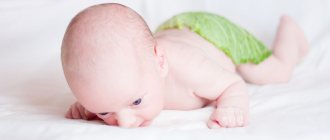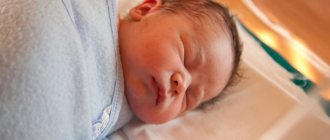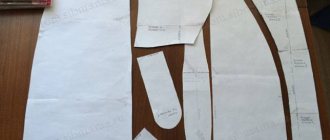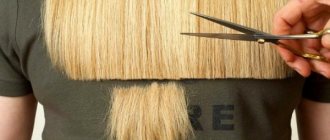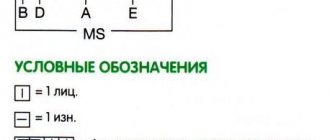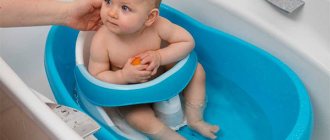What options are suitable for a baby blanket?
- There should be no allergic reaction to the product. Therefore, you should choose yarn that has a special “children's” mark. It's definitely perfect for knitting and you can't go wrong with it.
- The material also depends on what time of year the child’s birthday was. For example, if it is the end of spring or the beginning of summer, pay attention to combined cotton and acrylic threads. It will not be difficult to crochet a blanket for a newborn from such thin and light yarn, and the baby will not be too hot. For winter or autumn, it is better to opt for wool and acrylic threads of medium thickness. Such a soft blanket will perfectly retain heat.
- The next characteristic of the yarn is that it should not be “prickly” and cause irritation to delicate skin.
- The threads should not fluff, as their lint can get into the child’s mouth and respiratory tract.
- For a baby, it is advisable to choose pastel shades. Bright colors can cause discomfort in the baby and distract from sleep. As an example, you can rely on colors - blue, mint, pink, beige, lilac, etc.
Criterias of choice
In fact, the number of criteria in each specific case may be different. Let's focus on the main ones.
Size
When deciding on the size, you should not think that the bigger the better. In fact, a blanket that is too large will interfere with the baby when he begins to actively move his arms and legs. Moreover, the baby will get confused in the bulky blanket and even risk injury.
The most optimal sizes are generally recognized as 75x100 cm or 80x110 cm. By the way, the blanket does not have to be rectangular, it can be square, with sides measuring from 80 to 100 cm. This is at the discretion of the parents, whoever is more comfortable.
The blanket replaces the envelope for the statement, provides good air circulation in the summer and warms in the winter.
Material
Manufacturers offer a sufficient range of blankets from a variety of materials.
- Wool. Typically, wool blankets are knitted products that are created from pre-treated wool (yarn). It is important to remember that untreated wool is a strong allergen that can cause various symptoms: from skin irritation to respiratory problems. Therefore, trusted manufacturers use exclusively adapted hypoallergenic yarn.
- Fleece and other fabrics with small pile. This 100 percent polyester is lightweight and hypoallergenic. Fleece is also valued for its ease of wear, the possibility of frequent washing and quick drying - you must agree, the advantages are very important for children's blankets, because they will have to be washed often.
- Cotton. This natural fabric is used both as an independent bedspread (usually summer models) and as a cover for warm blankets with filling. Distinctive features of the material are breathability, hygroscopicity, and safety.
- Modal is a type of viscose fabric. Blankets for newborns are unusually light, practical, environmentally friendly, and breathable.
- Often there are blankets made from mixed threads: wool with synthetics or cotton with synthetics.
Design and color
For some reason, not all parents consider the choice of colors important, but in vain. Child psychologists and color therapists have long proven that color and design greatly influence the psychological and physical state of a child. Even the shades and patterns have meaning.
For a child under two years old, you can safely choose a black and white model, since the baby distinguishes only these two colors. But subsequently it is better to avoid black, red, orange or purple colors around the baby.
A snow-white plaid is always a win-win option.
By the way, delicate colors and drawings that are pleasing to the eye will give the mother some free time, as the child will look with interest at the shades he likes.
Delicate colors will attract the baby's attention.
Season
Another aspect to consider when choosing a blanket. A warm and dense product will be completely inappropriate in the summer, and, conversely, a light, airy blanket is inappropriate in the winter. For the cold season, it is quite possible to use faux fur blankets or wool models with filling. If it is very cold, then a sheepskin blanket blanket would be an excellent solution.
This sheepskin blanket will warm your little one. It will always be warm, soft and comfortable.
Well, for a warm spring or summer it is better to buy a blanket made of cotton, knitted fabric with a natural or mixed composition. Openwork bedspreads made of cotton threads look impressive.
Cozy and soft cotton blanket.
You should be especially careful when choosing a blanket if you are discharged from the maternity hospital during the off-season; it is better to play it safe and opt for a warmer option.
If you sew buttons to a warm blanket, you will get a warm envelope for your baby.
A few useful secrets from craftswomen
- The thicker the yarn, the less its consumption;
- A looser twisted thread has more economical consumption;
- More material will be spent on openwork and complex patterns;
- When knitting with an elastic band, several times more yarn is used;
- In some cases, thick knitting needles will help reduce skein consumption (not always).
Preparing for knitting
Before starting work, you need to choose a knitting method (knitting or crocheting), suitable threads and decide on the dimensions of the product.
Knitting needle selection
If the fabric is solid, then the knitting needles should be long enough, since the size of the blanket is relatively large. The exception is fabrics sewn from separately knitted squares and stripes. When the length of regular knitting needles is not enough, you can use circular knitting needles.
The size of the knitting needles in diameter depends on the desired thickness of the product, the selected threads, and the knitting pattern. The most frequently used:
- numbers 2.5; 3; 3.5; 6, if straight knitting needles are used;
- numbers 3.5; 5; 7 when using circular ones.
Important! Typically, the numbers of knitting needles used to use a given type of thread are indicated on the yarn label
Which yarn to choose
To make a blanket for a child with your own hands, you need to choose a yarn that will be safe for the baby and provide him with comfortable warmth in accordance with the weather conditions:
- for summer - light threads;
- for winter - thicker, containing wool and other warm components.
Yarn for knitting
Main recommended varieties:
- 100% cotton. Suitable for a summer blanket. Products made from such yarn are a bit harsh, so it is better to choose threads made of cotton with polyacrylic, then the blanket will be much softer;
- Acrylic. Synthetic yarn is also used for blankets for the summer. It will turn out soft but dense. There is a special acrylic yarn that is suitable for children. This is indicated by the information on the packaging;
- 100% wool. A good choice for a winter blanket, but sometimes causes skin irritation. It is better to buy mixed threads consisting of several natural ingredients with the addition of acrylic. For example, wool with bamboo and acrylic or wool with alpaca wool and acrylic.
When choosing threads for knitting, you need to consider:
- It is not recommended to use fleecy yarn, as the hairs will get in the way and get into the baby’s face;
- Low-quality acrylic will affect the performance characteristics of the product (the blanket will stretch out, losing its shape);
- It is better to choose thicker cotton yarn. It is necessary to ensure that the threads are free of defects. The thinner the threads, the shorter the service life of the product.
Choosing a blanket size
The dimensions of a knitted blanket for a baby approximately correspond to the size of diapers. To make it last longer, it is better to knit items in larger sizes. The minimum dimensions are 90x90 cm; this knitted blanket is suitable for a newborn at discharge. The maximum, more practical dimensions are 100x140 cm.
Calculation of the amount of yarn
To find out how many threads you will need to knit a blanket, you need to first knit a square with a side of 10 cm and then wash it.
Important! Pre-washing a sample product is necessary to assess how the size of the blanket will change after it. Next you need to do:
Next you need to do:
- Measure the side of the knitted square after washing and drying. Calculate how many such pieces will be in the finished blanket;
- Calculate the number of loops in order to know how many of them will need to be cast on for knitting;
- Unravel the square, after measuring the length of the threads that were used;
- Multiply the resulting figure by the estimated number of squares.
Important! If the package of yarn contains information only about weight and not about length, then the pre-knitted and washed square does not need to be unraveled, just weigh it. Additional factors that can affect yarn consumption:
Additional factors that can affect yarn consumption:
- thin threads are consumed more;
- knitting dense patterns requires an increase in the amount of yarn, openwork - vice versa.
Preparatory stage
Before you start knitting or crocheting a blanket for a newborn, you need to follow a few tips. They will help you create a quality product step by step and easier.
- Select and purchase suitable yarn, taking into account the tips from the previous paragraph;
- Choose your favorite pattern. Before you start making a blanket, carefully study the knitting pattern and try to knit a small training fabric;
- Make a calculation based on the resulting sample, based on the desired size of the future blanket;
- Select tools (hook or knitting needles) of the required size for the selected threads.
The pattern should not be very intricate, convex, too embossed, tangled or with additional fringe. The main thing is the comfort and safety of the child.
So it’s better to make a simple, cozy and light blanket that will last a long time.
Information for beginner needlewomen
If you want to knit a blanket yourself, but you have few skills, prepare for this process in advance. Study the forums of needlewomen who will help you with valuable advice, and prepare everything you need. Knitting a blanket is not at all difficult, but it is advisable to practice in advance and master the basic skills. Decide what you will knit with - crocheting or knitting. The hook forms more openwork loops, and with the help of knitting needles you will achieve greater density. The simplicity of the work lies in the fact that you don’t even need a pattern or difficult calculations.
In order to knit a neat blanket, select the required amount of yarn (it can be calculated depending on the knitting density and the size of the product), as well as knitting needles (their size also depends on the density of the loops you plan to make). As you work, be extremely careful not to miss a loop or to avoid any loose threads.
You can make a plain fabric, or you can make it two-color (knit with two threads at once or break it into diamonds). The second option is much more complicated and requires certain skills and dexterity. As for the parameters, the optimal size for a newly born baby is 80 cm in width and 110 cm in length.
Along with this they search and read:
Newborn Crib Blanket Size and Standard Newborn Swaddle Size
How to calculate the bedspread size
Since patterns of baby blankets for newborns vary, the size of the products also varies. For this reason, it is worth knowing how to calculate the necessary parameters and not make a mistake.
After all, a bedspread that is incorrectly selected in size may be too heavy or, on the contrary, it will be too small to completely cover the baby. And duvet covers are produced according to standard measurements, so you have to take into account various factors and conditions.
For a cradle, it is better to choose a blanket that is wider than that of a crib - this will help tuck the fabric under the mattress and secure the product, covering the baby with it. For walks in the cold season, a blanket measuring 140 by 100 cm is suitable. In summer, the size may be smaller - from 90 to 100 cm.
How to decide on the size of a baby blanket and pattern
Before you start knitting a blanket, it is important to decide what size it will be. The parameters of the product depend on where it will be used and how. You should not knit a blanket that is too heavy, as it will be uncomfortable.
If a blanket is needed for the discharge of a newborn, it should be of such a size that the child can be wrapped in it. A blanket measuring 0.8*1.2 meters is suitable for a standard crib. If you plan to tuck the blanket under the mattress so that the baby does not open up, then the optimal size will be 1.1 * 1.4 meters. The same sizes are also suitable for walking outside in a stroller.
For a summer blanket for a newborn baby, a length and width of 0.9 meters will be enough. It's enough to cover a child.
For a boy, you can knit a blanket from 20 motifs, each of which will be made in a different pattern. A product with a marine theme will be original. Before assembling the motifs, you need to wash them and dry them flat, then sew them with a needle. Finally, knit the border using garter stitch. The decorative stitching with a thread of a contrasting color looks interesting.
Simple baby blanket
One of the simple options that is suitable even for those who have just started knitting or do not have enough experience. A quick and simple master class in a few steps on how to make a blanket for a newborn will help you create this useful thing with your own hands.
For beginners, simple satin stitch or garter stitch patterns are more suitable. To work you will need:
- Yarn – 600 g,
- Knitting needles size 3.5
Keep in mind that the fabric knitted with a checkerboard pattern will be double-sided and very dense. The process uses both knit and purl stitches.
- Select the size of the squares based on the number of stitches. For example, 4 by 4. It will look like this: alternating four knits and four purls throughout the row.
- And there are, respectively, 4 such rows.
- The order is shifted - first 4 purls, and then 4 knits. And in this way the fabric of the required length is knitted.
- The squares can be of any chosen size, the main thing is to make preliminary calculations and know the required number of loops for the selected width.
Don't forget to add a couple of extra edge loops.
Material for the blanket
Due to the fact that I started knitting during the cold winter, the choice fell on my favorite Nako Alyaska:
- White color,
- 100 grams - 204 meters,
- composition: camel hair - 15%, wool - 25%, acrylic - 60%.
Over the past six months, this yarn has helped me knit a sweater for my son and a double-sided warm snood for my daughter. It is good because it does not have a pronounced knitted effect, i.e. almost no stretch. This product holds its shape well.
Since the beginning of knitting I have had 4 skeins of 100 grams each. As I knitted (at the beginning, I did not know the exact number of skeins), their number increased to seven. It was possible to knit further, but the size 110x120 seemed to me to be enough for now.
Festive blanket for baby
For a special occasion, for example, a discharge or one month anniversary, you can make a beautiful and original gift. Even in the photo, such a blanket for a newborn will look like a decoration.
If knitted in winter, the blanket can be additionally insulated with a lining. For the warm season, a simple knitted openwork product is also suitable.
The process will require the following materials:
- Acrylic yarn 350 g;
- Knitting needles size 3.5
With such tools and threads, the density should be 10 by 10 cm = 25 loops; 40 rows.
The knitting pattern comes in the form of hexagons, the height of which is approximately 20 cm. You will need 22 of these hexagonal motifs.
The process of creating one element:
- First you need to cast on 8 loops on the knitting needles.
- Row 1: edge stitch, knit 1, yarn over - repeat six times, edge loop.
- This rapport is repeated six more times. After 36 rows are completed, cast off the stitches.
- Also knit six half-motifs. Unlike the whole, there will be only three rapports here.
Step-by-step instructions for knitting a plain blanket for a newborn
A blanket for a newborn is always knitted in the same sequence of steps. First, the required number of loops is cast on the knitting needle, then the main fabric of the product is knitted, and finally the loops are closed and the decor is selected.
Before starting work, you need to decide on the desired size and pattern of the blanket, the type of yarn and the thickness of the knitting needles. It is better to knit a simple plain blanket for a baby with simple knitted yarn and not add decorative details. For beginners, it is better to start knitting with simple patterns. You can try making a blanket 80x80 cm with a square pattern. To do this you will need 350 g of knitted threads.
Set of loops
Any knitting must begin with a set of loops.
It's not difficult to do this:
- You need to take a skein of yarn and unwind a little thread.
- The unwound thread is taken by hand (for a right-handed person in the left, for a left-handed person in the right) and thrown over the index finger with the free end first.
- The same end is wrapped around the thumb from left to right, so as to form a figure eight with another thread.
- Both threads are clamped with free fingers.
- Two knitting needles are taken in the right hand.
- The knitting needles are inserted into the loop on the thumb from bottom to top, forming a loop.
- You need to pull the thread from your index finger into this loop, bringing the knitting needles from top to bottom.
- Next, the loop is removed from the thumb and tightened on the knitting needles.
- Then you need to put the thread back on your thumb and repeat the whole procedure.
Thus, 175 loops are cast on the knitting needles, after which 1 knitting needle is pulled out.
Knitting fabric
Before knitting the main pattern, you need to decorate the edge of the blanket. To do this, the first few rows should be knitted in simple garter stitch. Usually the first loops, which are called edge loops, are removed, but here they need not be removed, but knitted with facial loops.
The first 11 rows are knitted with simple knit stitches:
- The knitting needle with loops remains in the left hand, and the empty one in the right.
- The thread from the skein is thrown over the index finger and clamped with the remaining fingers.
- The free knitting needle is inserted into the starting loop from left to right. In this case, the tip of the knitting needle, passed through the loop, grabs the thread from the skein from the bottom to the top and pulls it back.
- A loop is formed on the free knitting needle. The old loop is removed from the knitting needle with the stitches cast on.
- The procedure will be repeated the required number of times, in this case - 175.
- The row ends with a purl loop. The thread is placed in front of the knitting needle, which is wound from right to left and grabs the free edge from top to bottom.
- In order for the product to be proportional, you need to make 10 increases in the 11th row using the double crochet method. To do this, after knitting 11 loops from the edge, you need to throw the thread over a working knitting needle and continue knitting with facial loops. Yarn over is repeated after every 18 stitches in the row.
- In the last row of the main fabric, you need to remove 10 added loops. You need to remove them in the same order as you threw them on. First after 11, and then after every 18, the knitting needle passes through two loops at once;
- The work ends with 11 rows of loops using the garter technique.
The main pattern is knitted taking into account that the first and last 7 stitches of the row will be knitted using the garter technique. The cycle consists of 24 rows and is repeated 11 times.
Knitting pattern for the main fabric:
| Row No. | Scheme |
| 1, 3, 9, 11, 14, 16, 22, 24 | 9 knit (the yarn over between the loops in the 1st row is knitted with a crossed knit), 9 purl, and so alternates 9 times. At the end of the row, 9 knit stitches are knitted. Then the product is turned over and the next row is knitted. |
| 2, 4, 10, 12,12, 15, 21, 23 | The knitting pattern differs only in that first 9 purls are knitted, then 9 knits and so on until the end. The row ends with 9 purl loops. |
| 5, 7, 17, 19 | Knit 3, purl 3, and so on until the end of the row, which should end with 3 knit stitches. |
| 6, 8, 18,21 | 3 purl, 3 knit, everything is repeated until the end, the last 3 purl loops are knitted. |
Closing the loops
To prevent the product from unraveling, the last row of loops must be closed.
To close the loops you need:
- Knit the first edge stitch.
- Knit the next stitch.
- Using a knitting needle with loops, you need to pick up the first loop and pull the second through it with a working knitting needle.
- Knit the knit stitch again and pull it into the previous one.
- Repeat across the entire row.
- When finished, seal the ends of the thread.
Decorating a blanket
After the blanket is knitted, it must be washed, laid out on a horizontal surface and given the desired shape. After drying, the edges of the product can be decorated with ribbons, tulle or lace. To make the decor look neat, it is sewn on with monofilament, a strong thread that resembles fishing line.
Triangle
To create it, the edges of the previously obtained hexagons are sewn together. The first and second of them are connected to each other.
- For a hexagonal element, you need to lift 20 loops from each side, and together, respectively, 40.
- The row is knitted inside out, after which there is a continuation from the first row to the 17th row inclusive.
- Row 18: 3 stitches are knitted together on the wrong side, after 2 purl stitches. To get one loop out of two, the first one is thrown over the next one.
- Using this principle, continue to knit triangles, and also do not forget about connecting hexagonal parts and half-hexagons together.
- Final stage: knit 200 stitches along the edges of the product. To edge the bedspread, you need to pick up about five centimeters of garter stitch.
During the process, add one loop on both sides every other row. You need to do this 10 times.
At the end you need to close the knitting loops and sew the edges.
Crochet blanket made from square motifs, models from our website
Cozy blanket, knitted from square motifs
Plaid Cozy. Materials: p/w yarn, about 1 kg, knitting needles with a diameter of 4 mm. Sample: persons. satin stitch 22 p and 30 r -10/10cm. For the first square, cast on 44 stitches and knit a row. Mark the middle with a marker and a colored pin. IN
How to knit square patchwork motifs for a pillow or blanket
Hello! At the beginning of summer, I published a post in which I posted my interior work using the patchwork technique, namely, a “Sand Castle” sofa cushion cover. You can view this work here. There you can also watch a video tutorial on
Children's blanket with dogs (imitation square motifs)
A cozy children's blanket with dogs will bring pleasure not only to children, but also to adults. Size: 82x86 cm. Materials needed: Cascade 128 Superwash yarn (100% wool; 117 m / 100 grams per skein) – 6 skeins of moss color (thread
Knitted blanket with arans and square motifs
The blanket is made of 20 squares. The size of each square is 15.5 cm * 17.5 cm. Blanket size 85 cm * 60 cm. You will need 4 colors of yarn and matching knitting needles; hook for tying a blanket. Complete 5 motives according to scheme A,
Knitted blanket made of square motifs for a newborn
Two square blankets for a newborn. Children's acrylic threads. I don't remember the footage. 50 g in a skein. Knitting needles 2.5 The size of the blanket ended up being 88*88 cm. Each color took 3 skeins. Knitted entirely in stockinette stitch. Each square of the blanket is knitted from 70 knit stitches,
Knitted baby blanket (square motifs with cats)
Blanket for future granddaughter. Size 75×72, weight 213 g. I specially knitted it in this size so that it could be used for discharge from the maternity hospital, if my daughter likes it, of course. Himalaya medical baby yarn (100g/310m). Composition: 70% acrylic and 30% amicor. The yarn is antibacterial, antiallergenic. Manufacturer's recommendation
Cats and mice plaid knitted from square motifs
Cats and mice plaid. Designed by Gitta Schrade, published in Family Circle Easy Knitting magazine, Winter 2001 “Double knitting” technique, Wool yarn, YarnArt, Turkey, 2.5 mm knitting needles, consumption 1800 g, dimensions 155x175cm. Additional motives are associated
Knitted blanket with cats from square motifs
Knitted blanket with cats - Anna's work. I knitted the blanket with knitting needles No. 2.5; I used yarn in 100 g = 380 m. For size 1.5*2.0, you need to knit 28 squares. One square consists of 72 loops. Cat knitting patterns:
Throw and cushion covers in square motifs
You will need: 2,200 g for a blanket and 300 g for one cover of white yarn (50% wool, 50% acrylic, 125 m/100 g). Straight knitting needles No. 6, hook No. 5, darning needle. Dimensions: blanket 120*160 cm, cover 40*40cm. Facial
Blanket of bright square motifs
Blanket size: 112×168 cm, 1 square 28×28 cm. To knit a blanket you will need: 200 g each of blue, purple, yellow-green yarn, 150 g each of golden and green yarn (55% wool, 45% polyacrylic, length 125 m/50 g), 200 g
Embossed plaid of square motifs knitted
This blanket is a showcase of different raised patterns, made in cheerful colors with knit and purl stitches - the perfect pattern for knitting between occasions. All squares are knitted separately and then joined together in patchwork style. Design by Sandy Prosser. Dimensions approx. 81cm
Photo of a blanket for a newborn
How to knit a blanket with knitting needles, diagrams from the Internet
Plaid knitted “zig-zag”
interesting selection on knitka.ru
Baby Blankets
Blankets for newborns and babies
The blanket is knitted gradually; individual parts do not require stitching. As a result, you get a double-sided canvas. Each strip can be knitted from a different yarn, allowing you to use up leftover yarn.
Chocolate blanket knitted
The brown bedspread is knitted in a braided pattern. Two opposite sides of the blanket are decorated with fringe.
Size: 89 x 145 cm without fringe.
You will need:
- 10 skeins of Plymouth Yarn Company Encore Worsted (75% acrylic, 25% wool, 180m/100g, color 6002) brown;
- Circular knitting needles 4 mm long 74 cm;
- Circular knitting needles 5 mm long 74 cm;
- Auxiliary knitting needle;
- Stitching needle;
- Hook corresponding to the thickness of the yarn
Knitting patterns:
- Facial surface: faces. R. – persons p., out. R. - purl P.
- Pattern for the edge: knit according to the pattern 1 number of stitches is a multiple of 20 + 12 stitches.
- Basic pattern: knit according to pattern 2, the number of sts is a multiple of 40 + 12 sts.
Knitting density, main pattern, 5 mm knitting needles: 40 sts, increased to 52 sts, and 30 r. = 19.5 cm x 10 cm
Description of knitting
- Cast on 302 stitches on 4 mm needles.
- 1st row: 5 knits, 292 stitches with a pattern for the edge according to pattern 1, 5 knits.
- Having completed 4 p. = 5 cm, switch to 5 mm knitting needles.
- Next row: 5 knits, 292 sts with the main pattern according to the pattern 2, 5 knits.
- Finish knitting at a height of 84 cm from the beginning.
- Next row: 5 knits, 292 stitches with a pattern for the edge according to pattern 1, 5 knits.
- Having completed 4 p. = 5 cm, finish knitting.
- Next row: 5 p., 292 p., 5 p.
- P. close.
Fringe: for each tassel, cut threads 25.5 cm long. Fold the tassels in half and attach them with a hook to the opposite sides of the blanket.
Knitting patterns
Warm blanket made from leftover threads with interesting embroidery
Once upon a time, when my daughter was still very little, my only hobby was knitting. My husband then gave me a knitting machine and I sat at the carriage for days. I knitted everything for the child, she was always the most fashionable and the most elegant one. And not only the child, even my father-in-law sported a fashionable pullover (he was still unhappy with his daughter-in-law).
What I mean is that over several years of such knitting practice I have collected a huge amount of leftover threads - three huge boxes with balls of different threads. There is nowhere to use them, but they keep piling up. When I saw this blanket, I felt great joy - after all, this is a great way to empty the house of what has been in the way for years.
You will need to crochet or knit several squares and embroider them according to the patterns below, or you can knit them - whichever is more convenient for you) Then collect all the squares, knit them together and tie the blanket around the edge.
Knitting pattern
Knitted blanket
Size: 65 x 165 cm. You will need: 8 skeins of Zealana Kiwi Lace Weight yarn (40% merino wool, 30% cotton, 30% possum wool, 199m/40g); circular knitting needles No. 3.5; 2 auxiliary knitting needles; 6 markers. Knitting density, sequence of patterns: 27 sts and 30 r. = 10 x 10 cm.
Blanket SAMPLER AFGHAN by Melissa Leapman
Melissa's famous blanket - that's how it was dubbed in the knitting world. This model with Celtic knots and weaves will require a lot of work, attention and diligence, but the result will delight you and everyone around you for a very, very long time.
Knitted blanket with embossed oak leaves
Knitting a blanket with oak leaves.
Size: approximately 183 by 223.5 cm.
You will need:
- 24 skeins of 50 g of Classic Elite Yarns Chalet yarn (alpaca/bamboo) steel color #7403 (steel)
- Circular knitting needles 6 mm, length 150 cm
- 2 double needles 6 mm for border
- Stitch markers (M)
- Hinge holders (DP)
Knitting density: 15 p. and 22 r. = 10 cm, faces. satin stitch, knitting needles 6 mm.
Openwork plaid
Such an openwork blanket, knitted with knitting needles, will be a wonderful option for discharge from the maternity hospital.
Materials
- Yarn (55% wool/33% microfiber/12% cashmere) – 450 g. This amount of yarn will make a knitted blanket 70 cm x 86 cm.
- Circular knitting needles No. 3.5.
Schemes for needlework
The pattern diagram is given only for front rows. The loops and yarn overs of the purl rows are knitted with purl knitting. The rapport begins with the loop before the rapport and ends with the loop after it.
Main canvas
The main fabric of the blanket is knitted from 159 initial stitches. The drawing is carried out according to the diagram. Knitting should be continued to a height of 85 cm.
Plank
The plank is knitted separately from 6 cast-on stitches. As you knit the strip, you need to try it on to the perimeter of the main fabric. As soon as the length of the strap is equal to the perimeter of the blanket, the loops are closed.
Assembly
Assembly consists of sewing the strip to the main fabric. The short edge of the strip also needs to be sewn.
A wonderful openwork blanket is ready!
Types of patterns for blankets, their knitting patterns
Crocheted children's blankets, the patterns and descriptions of which are described in the article, differ in patterns. A simple pattern can always be “played up” with yarn with an interesting thread structure or color. Or, as in the example below, use yarn colors with a smooth transition between colors. But even in traditional colors (pink and blue) such a blanket will look good.
Crochet baby blankets. Diagrams and descriptions will help you make a beautiful blanket for your child.
At a quick glance at the photograph, it may seem difficult to make such a spectacular drawing.
However, multi-colored inclusions are obtained due to the fact that after 1 row of white yarn a row of colored yarn is knitted, where they alternate in. loops and st. without a crochet.
If there are a lot of leftover yarns of different colors accumulated in the house, then it is recommended to choose a blanket model knitted from motifs; in addition, it is easier to knit such a product.
A bedspread with voluminous flowers not only looks impressive, but also has a massage effect for the baby.
The pink blanket with hearts has more of a decorative function. They can be used to make a crib or cover a child in a stroller.
An interesting solution is to use various decorative elements in a blanket, for example, pompoms. A fairly simple image of a hare immediately becomes cute and original.
The pattern does not have to be knitted on a blanket. It can be done separately and then sewn on. Children will be happy to touch such an applique, developing tactile sensations.
